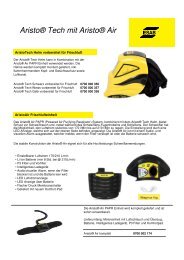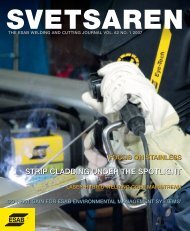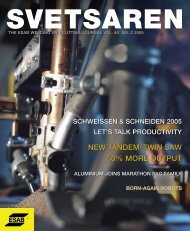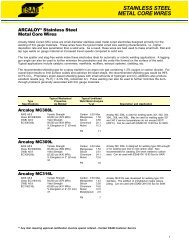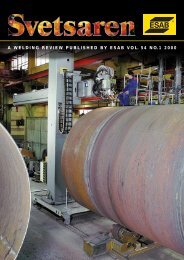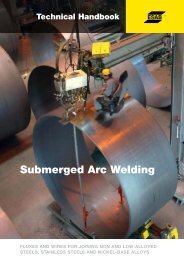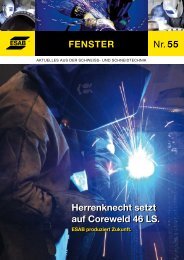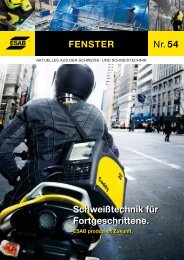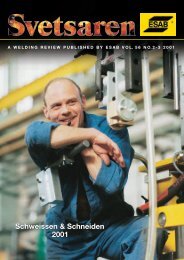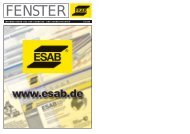Svetsaren_nr2 definitief (Page 1) - Esab
Svetsaren_nr2 definitief (Page 1) - Esab
Svetsaren_nr2 definitief (Page 1) - Esab
Create successful ePaper yourself
Turn your PDF publications into a flip-book with our unique Google optimized e-Paper software.
Alloy type UNS ISO name Cu Ni (%) Fe (%) Mn (%), Ti (%)<br />
Alloy No.<br />
max<br />
90Cu-10Ni C70600 CuNi10Fe1Mn Bal 9.0 – 11.0 1.0 - 1.8 1.0 -<br />
70Cu-30Ni C71500 CuNi30Fe1Mn Bal 29.0 - 33.0 0.4 - 0.7 1.0 -<br />
Consumables AWS A5.7 DIN 1733<br />
70Cu-30Ni ERCuNi SG-CuNi30Fe Bal 29.0 – 32.0 0.40-0.75 1.0 0.20 – 0.30<br />
-"- <strong>Esab</strong> OK <strong>Esab</strong> OK<br />
Autrod 19.49 Tigrod 19.49 -"- -"- -"- -"- -"-<br />
Table 1. Compositions of most common copper-nickel alloys.<br />
The second weld performed at the welding laboratory<br />
at ESAB Finland was already a success. The orbital<br />
TIG welding of copper-nickel alloy CuNi10Fe1Mn was<br />
found to be fairly easy using a PROWELDER power<br />
source and a PRB welding head (Figure 1). The finish<br />
of the weld was excellent full penetration all the way<br />
(Figure 2). The basis for quality and productivity<br />
improvements had been established.<br />
Improvements in productivity compared with brazing<br />
were very high. It took only around one-tenth of the<br />
time compared with brazing. This was also confirmed in<br />
yard practice.<br />
What are copper-nickel alloys<br />
Copper-nickel alloys known as Cunifer were developed<br />
for seawater use. They typically contain between 5 and<br />
30% nickel with specific alloys with additions of iron and<br />
manganese. The two grades that are typically used in<br />
welding applications are 90-10 and 70-30 copper-nickel<br />
alloys (Cu/Ni) (Table 1). Copper-nickel alloys, or cupronickels,<br />
can be welded with most arc welding processes:<br />
MMA, MIG, TIG. Surprisingly enough, it also is fairly<br />
easy to resistance spotweld, in spite of the high copper<br />
content. The addition of nickel reduces the electrical<br />
conductivity to such an extent that a joint can be made.<br />
An all-purpose welding consumable for copper-nickel<br />
alloys is of the 70-30 type with the addition of titanium as<br />
a deoxidiser. The typical composition is shown in Table<br />
1, together with the most common alloy nominations.<br />
How to make a good weld<br />
If copper-nickels are treated with the same kind of care<br />
in welding as stainless steels, no problems should arise<br />
with the weldments. As copper-nickel alloys are prone to<br />
oxidisation, precautions to prevent this must be taken,<br />
just as they are when welding stainless steels. Gas<br />
purging inside piping is also necessary as proper gas<br />
protection on the surface side. The use of Ar-H 2 mixed<br />
gases reduces the risk of oxidisation and leaves a brighter<br />
surface after welding compared with pure argon.<br />
The welding of copper-nickel alloys is very similar to<br />
the welding of low-alloyed steels as far as weld pool<br />
fluidity is concerned. The use of welding wire is highly<br />
recommended because autogenous welds are more<br />
likely to have porosity. If it is possible to organise,<br />
copper backing bars can be used. This widens the<br />
available parameter range and helps to ensure fullpenetration<br />
welds.<br />
Figure 2. Weld<br />
appearance and<br />
macro of orbital weld.<br />
Bevelling for orbital TIG welding is not necessary<br />
up to thicknesses of approximately 3 mm. Butt-joints<br />
with a zero gap are recommended. However, for<br />
thicker materials, a U-groove preparation with a 1.5<br />
mm root face, 1.5 mm extension and 2 mm radius and<br />
zero gap is recommended. The bevelling angle depends<br />
on the process that is used for filling runs. For TIG<br />
filling, a bevelling angle of 2° may be enough, while for<br />
other processes 25-30° is more suitable.<br />
Links about welding copper-nickel alloys:<br />
• http://marine.copper.org<br />
• www.twi.co.uk<br />
About the authors<br />
Kari Lahti is product and marketing manager MIG/MAG,<br />
ESAB AB, Gothenburg.<br />
Juha Lukkari is head of the technical customer service,<br />
ESAB Oy, Helsinki.<br />
10 • <strong>Svetsaren</strong> no. 2 • 2002




